Indoor flowers add a special coziness to any home. When choosing indoor plants, women generally prefer unpretentious species that do not require special care. But in vain! The most capricious indoor plants bloom very beautifully. Indoor flowers and caring for them imply that the housewife must love plant growing and must be sensitive to home flowers.
In this material we will try to tell you as fully as possible about indoor flowers, as well as provide information on indoor flowers: photos and names.
Home flowers: photo
A popular plant with graceful drooping stems, it blooms with tubular flowers in spring. Can be grown in hanging baskets, but hang where it can come into contact with people and animals. The plant has sharp spines 3 mm long. Aporocactus blooms for about 8 weeks.
Care: before planting, the cuttings are dried for two to four days; they can be replanted in the spring. For the summer, place the pot outside. The plant is suitable for moderate room temperature; in winter, preferably 7-15°C. From spring to autumn, abundant watering is necessary. Let the top layer of soil dry out between waterings. In winter, water no more than once a month or two months.

A difficult and expensive plant to cultivate, the inflorescences-cobs of which look like a brightly colored “tail” with a large blanket of various colors with a waxy surface. Blooms from spring to late summer.
Care: can be replanted once every two years in the spring. Direct aerial roots into the soil. Grows in moderate room temperatures; in winter not lower than 13°C. Light: A bright place, but not in direct sunlight. Water deeply from spring to fall; limit watering in winter. Air humidity: spray the leaves regularly; the air must be constantly humid.

It blooms in summer with small white flowers, from which red berries develop by December. The fruits remain on the plant for several months.
Care: requires coolness in winter, does not tolerate drafts. Don't let the soil dry out. If necessary, it can be replanted in the spring; at the same time, it must be pruned. Temperature: moderate room temperature; in winter not lower than 7°C. Light: A bright place, but not in direct sunlight. The soil should remain moist, but not waterlogged; limit watering in winter. Air humidity - spray the leaves regularly.
Bilbergia - home flowers: photo

Billbergia drooping can be considered one of the most common and unpretentious indoor plants. Arc-shaped inflorescences appear among the grass-like leaves in early summer. The flowers are drooping, variegated, with showy dark pink bracts. Young plants bloom quickly.
Care: replant in the spring if the pot becomes too small. After flowering, remove the mother rosette to allow young rosettes to develop. Grows at moderate room temperatures; in winter not lower than 7°C. Light: A bright place, but not in direct sunlight. There should always be water in the middle of the rosette of leaves. Change the water every two months. Don't let the soil dry out. In summer, spray the leaves from time to time; Apply foliar fertilization once a month.
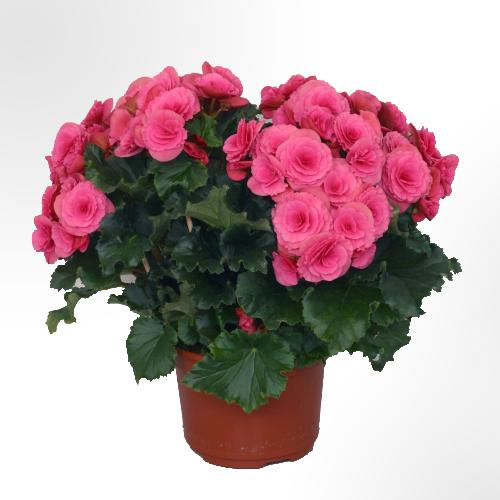
Decorative flowering potted begonias are used as temporary indoor residents. The most spectacular flowers (10-15 cm in diameter, bloom in summer and autumn) are found in tuberous begonias. Plants of the Lorraine group, or Cheimantha, bloom in December. Hybrids of the Elatior group bloom all year round.
Care: After flowering, they are usually thrown away, but the tubers can be used for propagation. Temperature - moderate room temperature; in winter not lower than 13°C. Light - a bright place, but not in direct sunlight. Watering - abundant watering during flowering. Let the top layer of soil dry out between waterings. Outside the flowering period, the soil should be constantly moist. Air humidity - regularly mist the air around the plant, but not the leaves.

A tall plant that tolerates dry air in rooms with central heating and interruptions in watering.
Care: does not tolerate waterlogging of the soil. You can replant once every three years in the spring. For the summer, place the pot outside. Requires moderate room temperature; in winter not lower than 10°C. Keep in a bright place, preferably direct sun for part of the day. Water deeply from spring to fall. Let the top layer of soil dry out between waterings. In winter, water no more than once a month or two months. You don't have to spray.
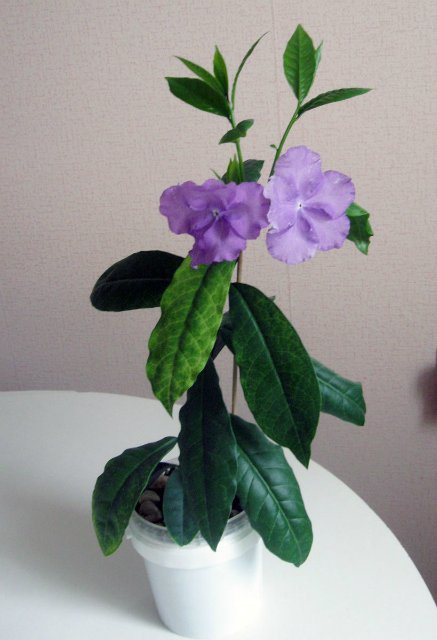
The flowers change color from purple to lavender and then white. Does not tolerate sudden changes in temperature. Fragrant flowers up to 5 cm in diameter with a white throat. Blooms almost all year round.
Care: in spring, slightly shorten the stems; in summer, pinch the ends of the stems to enhance branching. Affected by scale insects. Replant in spring if necessary. For the summer, place the pot outside. Temperature: moderate room temperature; in winter not lower than 10°C. Light: bright place; Direct sun is desirable for part of the day. Abundant watering from spring to autumn; limit watering in winter. Humidity: Mist leaves occasionally in hot weather.
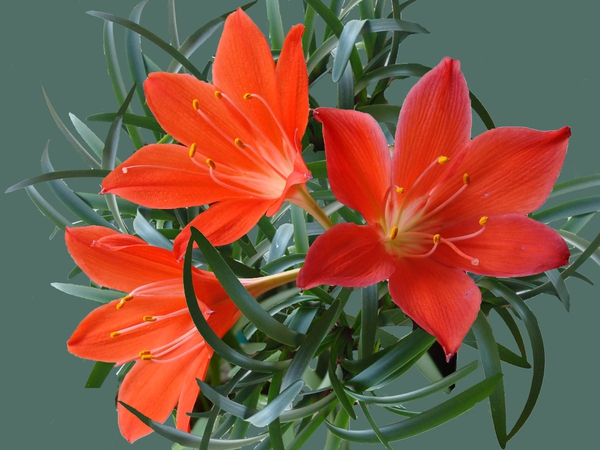
Easy to grow bulbous plant. Blooms in late summer. The bulb is planted in the spring, half buried in the soil. The pot is placed on sunny windowsill. Long-lasting, bell-shaped flowers with a diameter of 8 cm sit in groups of several on tall peduncles. The usual color is red, there are varieties with white and salmon flowers. The leaves are narrow, 30 cm long, and do not die off completely after the flowers fade. In winter, place in a cool place.
Care: during transplantation, the offspring are separated and planted. Replant once every three years in the spring. Remove faded flowers Temperature: moderate room temperature, preferably 10-15°C in winter. Keep in a bright place with direct sunlight for part of the day. Abundant watering from spring to autumn; limit watering in winter. Spray the leaves from time to time.
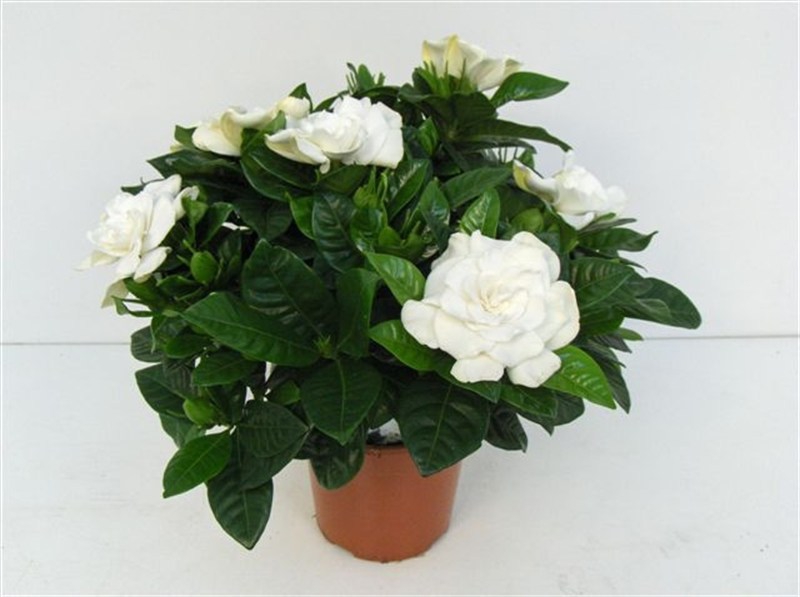
A beautiful plant with shiny leaves and fragrant flowers. Requires careful watering and constant moderate or elevated temperature air.
Care: replant once every three years in the spring. In spring, shorten the elongated stems. Moderate to elevated room temperatures are required; in winter not lower than 15°C. Keep in a bright place, shade from the midday sun in summer; gardenia is a shade-loving plant. The soil should remain moist, but not waterlogged; limit watering in winter. Spray the leaves regularly.
![]()
Fleshy leaves are arranged in two rows, tubular flowers sit on tall peduncles. The plant is light-loving and does not like waterlogged soil in winter.
Care: replant if necessary in spring. For the summer, place the pot outside. Moderate room temperature is required, preferably 10-15°C in winter. The plant loves light; In summer, shading from the midday sun may be needed. Abundant watering from spring to autumn. Let the top layer of soil dry out between waterings. In winter, water no more than once a month or two months. Do not spray. The soil should dry out well between waterings.
How to make simple flower food at home. Let's figure it out. For good growth and abundant flowering our plants need good soil, proper care and carrying out timely fertilizing with a full range of fertilizers. In addition to purchased fertilizers, homemade fertilizers prepared with your own hands are used. One of the main growing conditions is good lighting. We water only with warm, settled water until the soil is completely wetted. After an hour, you can start feeding.
An infusion of wood ash is well suited for feeding and preventing certain diseases. To prepare, take two tablespoons of ash per liter of hot water. I let it sit for three days, then water the flowers once every two weeks.
An excellent supplement is banana peel infusion. I leave it in cold water for a day, filter it and water it. Banana peels can be finely chopped, dried and added to the soil.
For foliar feeding and for the prevention of a number of diseases, I spray plants with infusion onion peel. I bring two handfuls of husks to a boil in a liter of water. I insist for two or three hours and strain. I spray it with fresh infusion.
To increase plant immunity and better flowering, I water the flowers with a solution a couple of times in spring. succinic acid. I dilute one tablet in a liter of warm, settled water. To stimulate growth and increase plant immunity, for better rooting of cuttings, it is good to use aloe juice in a dilution of 1 to 10.
For abundant flowering, experienced gardeners recommend using Castor oil(one teaspoon per liter of water). Before watering, shake the solution well to mix the oil and water. Directly for geraniums, it is recommended to add a drop of iodine to the water for irrigation. There are recommendations to water plants that are not developing well with the following solution. Pour one egg white into a glass of warm water and leave for five days. Next, dilute it in two liters of water and water it.
It is good to use a yeast solution to feed and stimulate plant growth. This solution improves the soil, suppresses the development of a number of diseases, is a growth stimulator and root former. I am doing the following feeding. For a liter of warm water, I take 50 grams of yeast and a teaspoon of sugar, let it sit for two hours, and water the flowers in a dilution of 1 to 10. Plants respond well to feeding with water that remains after washing meat or fish. I carefully rake the soil in one place, water it and cover it with soil. A decoction of chamomile and calendula accelerates plant growth and disinfects the soil.
How to care for indoor flowers. Poor plant development is usually not caused by the right conditions maintenance and care. In this case, immunity is reduced, conditions are created for the emergence of diseases and pests. With proper care, indoor flowers will delight you with lush blooms.
I advise you to read similar articles.
Replant or transship indoor flower? To do right choice, let's look in detail at all the situations in this section of caring for indoor plants.
The main period when potted houseplants are replanted is the first month of spring. At this time, with increasing daylight hours and rising temperatures, plants come out of dormancy, shoots and leaves begin to grow, and buds begin to form. For development in the new season, it is necessary to renew the soil in the pot. That small volume of substrate from which our flower took nutrition for last year, depleted of elements, the soil was compacted and salted. By replacing the soil and giving the roots more space to develop, after replanting the plant will become significantly stronger and grow over the summer.
When a transfer or transhipment is required:
30 Oct 2017
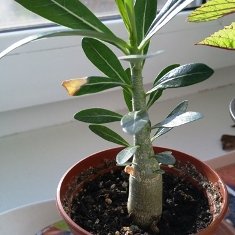 No one remains indifferent when they see indoor flower adenium. In addition to the magnificent flowers, this plant has an original trunk thickened at the base - the caudex. Experienced gardeners know how to shape the crown and lower part of adenium so that the plant looks like a bonsai - an adult tree in miniature.
No one remains indifferent when they see indoor flower adenium. In addition to the magnificent flowers, this plant has an original trunk thickened at the base - the caudex. Experienced gardeners know how to shape the crown and lower part of adenium so that the plant looks like a bonsai - an adult tree in miniature.
How to grow adenium at home, ask flower growers interested in this plant. Adenium is unpretentious, anyone can grow it, knowing the preferences in content and the peculiarities of caring for the flower.
Adenium comes from the desert regions of Africa; in order to endure dry periods, the plant has developed the ability to store moisture in its trunk, which results in a thickening at the base. This is a very light-loving and heat-loving plant, which is called the “desert rose”, but unlike cacti it has leaves.
14 Oct 2017
 If you like houseplant money tree or crassula or crassula, then you can grow it yourself from a small cutting to a large size with a branched crown. We'll tell you what difficulties you'll encounter when caring for a money tree, how to properly replant a plant and form a crown
.
If you like houseplant money tree or crassula or crassula, then you can grow it yourself from a small cutting to a large size with a branched crown. We'll tell you what difficulties you'll encounter when caring for a money tree, how to properly replant a plant and form a crown
.
30 Sep 2017
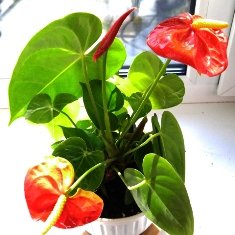 Each living organism has its own energy, so when purchasing a room one, know that each flower has magical powers that can awaken certain emotions and moods in us. If you want your home to always be filled with joy and happiness, place a couple of potted flowers in it symbolizing family well-being.
Each living organism has its own energy, so when purchasing a room one, know that each flower has magical powers that can awaken certain emotions and moods in us. If you want your home to always be filled with joy and happiness, place a couple of potted flowers in it symbolizing family well-being.
We offer small selection the most popular indoor flowers to attract happiness to the house with names, photos and brief description rules of care:
02 Mar 2017
 Onions are used in every kitchen, as this vegetable is included in the recipes for most main dishes. After peeling the onion, onion peel remains, which most people throw away because they do not know that it can be used in various fields, from treating diseases using prescriptions traditional medicine, in cosmetology, to the preparation of infusions and decoctions from onion peels, which are used as fertilizer for plants and to protect them from pests and diseases. In this article you will learn how to use onion peels when growing indoor plants and vegetables in the garden.
Onions are used in every kitchen, as this vegetable is included in the recipes for most main dishes. After peeling the onion, onion peel remains, which most people throw away because they do not know that it can be used in various fields, from treating diseases using prescriptions traditional medicine, in cosmetology, to the preparation of infusions and decoctions from onion peels, which are used as fertilizer for plants and to protect them from pests and diseases. In this article you will learn how to use onion peels when growing indoor plants and vegetables in the garden.
The use of onion peels in growing plantsis safe means for a person. Since the infusion does not contain toxic substances, it can be sprayed on home plants or vegetable crops and flowers in the garden without using protective equipment and without worrying about environmental pollution.
15 Feb 2017
 When arranging a children's room, mothers ask themselves the question: “Which indoor plants are safe for children and will only have a beneficial effect on the child’s mood and the atmosphere where the child spends most of his time?” Choosing indoor plants for children's room, find out all the information about each species, whether this plant is poisonous, it should not have a strong aroma, does not cause allergies, and how it affects a person’s energy and mood.
When arranging a children's room, mothers ask themselves the question: “Which indoor plants are safe for children and will only have a beneficial effect on the child’s mood and the atmosphere where the child spends most of his time?” Choosing indoor plants for children's room, find out all the information about each species, whether this plant is poisonous, it should not have a strong aroma, does not cause allergies, and how it affects a person’s energy and mood.
21 Jan 2017
 Nowadays a large number of phalaenopsis orchids are sold, these unpretentious beautiful flowers Many people buy it as a gift or to decorate their home. In order to phalaenopsis orchid long years colors at home you need to know the features of caring for this flower, and the main factor in the development and flowering of any plant is proper watering.
Nowadays a large number of phalaenopsis orchids are sold, these unpretentious beautiful flowers Many people buy it as a gift or to decorate their home. In order to phalaenopsis orchid long years colors at home you need to know the features of caring for this flower, and the main factor in the development and flowering of any plant is proper watering.
Water is the basis of life for all plants; proper watering of indoor flowers at home should be individual for each type of plant, according to need. Phalaenopsis orchid is tropical plant and many people think that this flower requires a lot of moisture, this main mistake beginning flower growers. Phalaenopsis tolerates short-term drying out better than a constantly moist substrate that does not dry out, in which the thick cord-like roots of the orchid quickly rot and die.
16 Jan 2017
 When choosing a houseplant, we mainly pay attention to the shape, appearance of leaves and flowers, but each plant has its own energy and properties, thereby affecting the human condition. When choosing indoor plants for a particular room, you should take into account not only the lighting conditions, temperature and humidity in it, but also the purpose of the plant to create the desired atmosphere and decorate the interior.
When choosing a houseplant, we mainly pay attention to the shape, appearance of leaves and flowers, but each plant has its own energy and properties, thereby affecting the human condition. When choosing indoor plants for a particular room, you should take into account not only the lighting conditions, temperature and humidity in it, but also the purpose of the plant to create the desired atmosphere and decorate the interior.
The bedroom is an important place in the house for a person; in this room we relax and gain strength during a sound sleep. Fresh air, relative coolness, and a calm, relaxing environment contribute to complete rest. Indoor plants with the ability to clean the air from dust, harmful substances, pathogenic bacteria and saturate it with oxygen are best suited for the bedroom. The appearance of indoor plants for the bedroom should have smooth lines and an elegant shape; most hanging and climbing plants with long shoots or leaves falling down from the pot fit this description.
30 Dec 2016
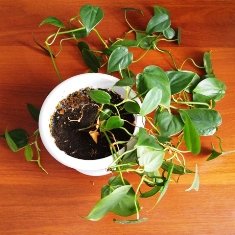 Climbing indoor plants with decorative leaves are indispensable for landscaping apartments, interiors of rooms with high ceilings and stairs. Thanks to the long flexible and plastic stems, climbing plants can easily take on any shape; for example, you can create a green figure from them by securing the shoots to a figured support. Climbing houseplants are best suited for wall landscaping and can be grown in a hanging form, leaving the stems hanging freely from hanging baskets, tall stands or shelves.
Climbing indoor plants with decorative leaves are indispensable for landscaping apartments, interiors of rooms with high ceilings and stairs. Thanks to the long flexible and plastic stems, climbing plants can easily take on any shape; for example, you can create a green figure from them by securing the shoots to a figured support. Climbing houseplants are best suited for wall landscaping and can be grown in a hanging form, leaving the stems hanging freely from hanging baskets, tall stands or shelves.
The most unpretentious and easy to care for are decorative deciduous climbing indoor plants. Unlike beautiful flowering ones, they do not require less light, which means they can be placed in the back of the room. Climbing indoor plants are versatile and fit perfectly into any setting in the kitchen, living room or bedroom. Indoor plants with decorative leaves not only decorate the house, but also serve as an air purifier, like a filter, collect dust, absorb harmful substances and increase humidity.
There may be several reasons for the leaves of indoor plants drying out; after a thorough examination, analysis and description of the damage, determine why the leaves of indoor plants are drying.
Most often, the leaves of indoor plants begin to dry in the autumn-winter period. For indoor plants, this is a testing time, due to reduced lighting and heating, the worst conditions for plant life are created.
Like all living things, they have a time of growth and a time of rest. These periods should be taken into account. If you don't follow the rules, you can seriously harm your pets. This article will discuss how to care for indoor plants so that they delight you with their beauty. It will be especially useful for beginners in flower breeding.
Caring for indoor plants, basic rules
- Warm. Temperature - important rule for a healthy flower. Correctly selected temperature is the key to a healthy and strong plant. Which in time will delight you with abundant flowering or beautiful foliage. There are heat-loving and cold-resistant plants; this must be taken into account when purchasing.
- Light. Light regime plays an important role in the growth of indoor flowers. Before purchasing a plant, you should determine exactly which side of the house or apartment the windows face. If you place a light-loving flower on a north window, where there is little light, it will simply wither. And shade-tolerant plants on the south window will get leaf burns and may die completely. In winter, artificial lighting is used for some plants.
- Watering. Another important factor in the main rules on how to care for indoor plants. With proper watering, home flowers will delight you with emerald and lush foliage, abundant and long flowering. It is with water that plants receive all the necessary nutrients for life, growth and reproduction.
By observing these simple tips, you can find an approach to any flower, both unpretentious and capricious. Among the abundance of indoor flowers, it is worth paying attention to the Crassula, or money tree, which is unpretentious to watering, light and air temperature. Ideal for a beginning gardener.

Money tree (houseplant): how to care
Crassula, Crassula, or the more familiar money tree, belongs to the family Crassula, a genus of succulents. It has about 350 varieties, from dwarf trees of a few centimeters to huge trees.
Homeland - South Africa. This means that the plant is very unpretentious; if properly cared for, it will reward the grower with a lush crown of fleshy leaves and small white flowers.
Basic rules for caring for a money tree
Temperature: The plant adapts perfectly to temperature changes in the apartment. In winter it tolerates dry air from radiators, cold from windows, in summer it easily tolerates heat, and in autumn it tolerates dampness and lack of sunlight.
In summer, it is necessary to take Crassula out to the balcony, loggia, veranda or garden. Temperature changes during the day have a beneficial effect on the growth of the fat plant. It hardens, grows fleshy leaves, and acquires strong immunity.
In winter, the money tree prefers cool temperatures, +7...+12 degrees. It is advisable not to place it near the battery. The hot air causes the plant to shed its leaves. In addition, they become smaller, losing their attractiveness.
Watering: V winter time minimize. Water once every 10 days. If the Crassula remains to spend the winter on a warm balcony, stop watering completely. If this rule is not followed, the stem and roots will rot, leading to the death of the entire plant.

In summer, water as the soil dries out. After the top layer has dried, you can wait another 4-5 days and only then water it. Crassula has the property of accumulating moisture in its fleshy leaves, so it is absolutely not afraid of underwatering.
Light: loves light, but not direct sunlight. The leaves get burned from the bright sun and appear on them. brown spots. In summer, the plant should be shaded with curtains or moved to a little shade.
Although the fat woman puts up with the lack of light, she still prefers bright and spacious windows. It is advisable to follow this rule at any time of the year. Due to lack of light, the money tree stretches and loses the splendor of its crown.
Zamioculcas, dollar tree (houseplant): how to care
Another representative of Africa is Zamioculcas, or dollar tree. It is an evergreen and perennial plant of the Araceae family. Flower growers love it for its beautiful fleshy leaves and unpretentiousness. Caring for a plant is very simple; if you follow these simple rules, the question of how to care for indoor plants will seem very easy.
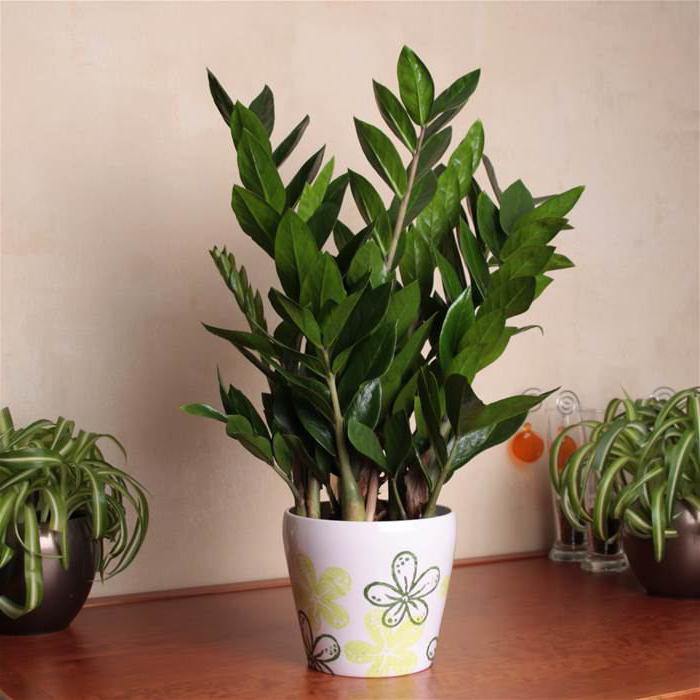
Basic rules for caring for a dollar tree
Temperature: preferably +20...+25. In winter it prefers cool air: +15...+17. In summer it grows well in the fresh air. But it can’t stand drafts and can get sick.
Watering: moderate in summer and spring, once every 10 days. Make sure that the soil in the pot dries out completely. Otherwise, the roots will rot and the plant may die. In winter, watering is kept to a minimum. It is enough to water the plant once a month, you can spray it periodically.
Light: Prefers diffused light, but not dark. In order for the dollar tree to grow strong and beautiful, it needs a bright room, but it must be avoided from exposure to sunlight. They leave burns on the leaves.
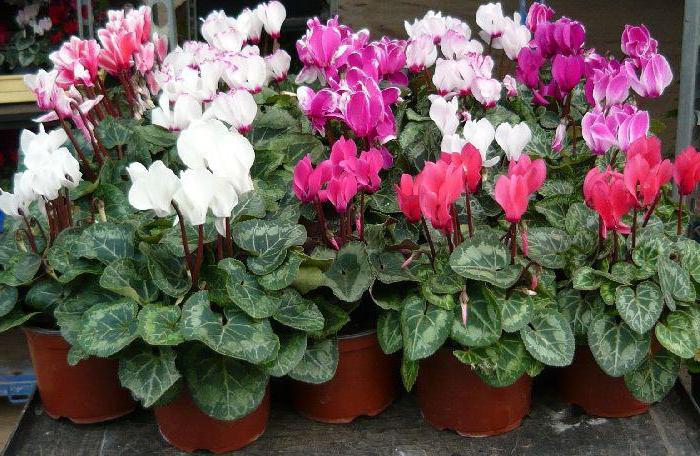
Bright cyclamen
And this blooming beauty can only be grown experienced flower growers. The flower is bright, festive, striking with its riot of colors and malachite greenery. In order for cyclamen to delight you with its flowering in winter, special conditions are required.
What care do tuberous indoor plants (cyclamen) require? How to care for them so that they delight you in winter with their lush and short-lived flowering?
Basic Rules
Temperature: the main parameter of a healthy plant. In winter, daytime temperatures are +13...+15, at night +5...+10. Such changes ensure flowering within a month. At higher temperatures, the flower stops blooming. It may even drop its leaves, “deciding” that it’s time to rest.
Does not tolerate stuffy rooms and stale air. Therefore, you should ventilate the room more often, but avoid drafts. Cyclamen doesn't like them.
Watering: This is a flower that requires careful watering. Do not pour water into the middle of the outlet. Water getting on the tuber causes it to rot. Water strictly along the edge of the pot, making sure that upper layer the soil dried out well.
In summer, reduce watering, but do not stop completely. The plant continues to grow and expand its root system. In order not to make mistakes with watering in the summer, you should pay attention to the condition of the leaves. As soon as the leaves lose their elasticity, it is necessary to water the plant abundantly.
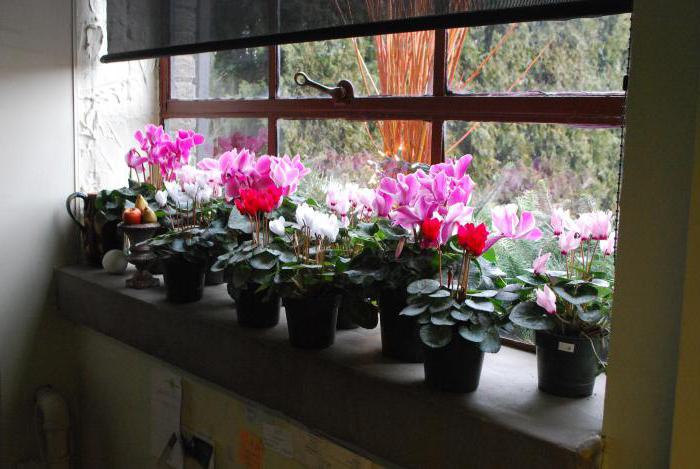
Cyclamen is not picky about water hardness. The main thing is that the water is settled and has a temperature 1-2 degrees below room temperature. In winter, it is good to spray the flower, but before the flowers appear. Buds do not tolerate such manipulations. They will fall off instantly, and if they remain, the flowers will have brown spots.
Light: bright but diffuse. Cyclamen feels good on east and west windows. In summer, the plant should be shaded from sunlight. Cyclamen - flower short day, does not require additional lighting.
By following everything described above, knowing how to properly care for indoor plants, a beginner in indoor floriculture will avoid many mistakes and troubles.
Children and indoor flowers
A small child is very sensitive to the surrounding nature. He will be happy to water, loosen and spray the flower. The main thing is to know how to care for indoor plants. Children need to be told and explained in detail what this or that roommate likes.
A good idea is to give your child a flower he likes; it will belong only to him. And the baby reverently and with great love will take care of his pet.
The young plant will grow together with its little owner. An invisible connection appears between them. The child becomes more responsible; he understands that without his attention the fragile plant will simply die.
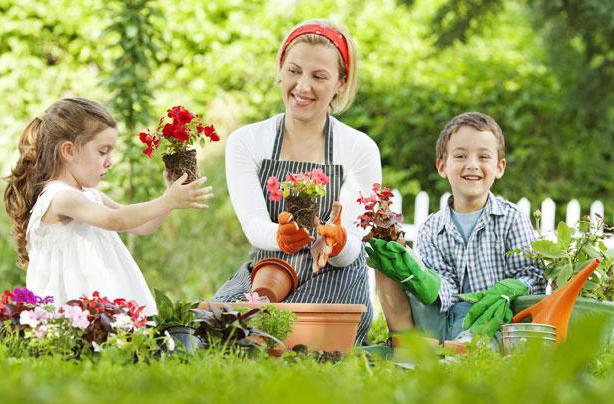
And the plant, feeling the care of its little owner, begins to grow actively, delighting those around it with lush greenery. And if it is a flowering plant, it will delight the baby and his parents with abundant and beautiful flowering.
The bond between a child and his houseplant will last for many years. And this relationship has a beneficial effect on the baby and, of course, on his favorite flower. The main thing is to successfully choose the right plant for your baby.
That's all the simple rules on how to care for indoor plants.
People who start growing flowers at home often notice that no matter how much they cherish their pets, they still wither and often die. There are several reasons for this that need to be understood.
There are several reasons why plants wither. Let's look at the main three: excessively dry soil, overly moist soil, and infection with various pests and diseases.
If, when examining the flower, you do not find dry or waterlogged soil, as well as pests, you need to inspect the roots of the plant, since insects can sometimes settle on the roots.
If the roots of the plant are healthy, but they occupy almost all the soil, this may indicate that the plant is sick due to lack of nutrition, so it must be transplanted into a new pot (larger in size) filled with fresh soil.
If upon inspection you notice that the roots are rotting or withering, you need to remove their damaged parts and replant the plant in new soil. It is also necessary to inspect the ground in which the plant was located. If it is too dry, it is necessary to take measures to moisten it evenly.
If the cause is dry air, the plant must be sprayed with clean water daily, and in winter (during the heating period) the radiators must be covered with a damp towel to maintain air humidity. The reason for the wilting of a plant can also be dust accumulated on its leaves. IN in this case It is necessary to wipe the plant with a clean damp cloth so that the breathing process is not disturbed.
A houseplant needs to be given a shower at least once a week to prevent the occurrence of spider mites, thrips, aphids and other pathogenic fungi. This also has a good effect on the appearance of the plant.
Dried and withered parts of the plant must be removed, because they are an excellent place for the proliferation of pathogenic bacteria. The cleanliness of the pots in which the plants are located is also extremely important: you need to check the drainage holes for blockages, wipe off dust from the pots, etc.
Temperature compliance

In order for plants to grow and develop well, they need a comfortable air temperature. They grow well in warmth, but poorly in cold. the most comfortable temperature for the plant is between 12-32 degrees. If the temperature is below 12 and above 32 degrees, the plant slows down its growth or stops growing altogether.
Different plants require different temperature conditions. Plants from tropical climates, for example, are kept in rooms with a temperature of 15-20 degrees, but hardy plants from tropical and subtropical countries can be kept at a lower temperature - 8-12 degrees.
However, there are plants that are not affected by air temperature, and they can develop and grow at any temperature (dracaena, aloe, etc.). Some plants do not tolerate temperature changes quite well. In winter, for example, the temperature at the window is 1-2 degrees lower than the temperature in the room, and on the windowsill about 4-5 degrees lower.
If the preferential temperature at which it must be kept is not indicated for a plant, but only that it should be at least 12 degrees is noted, this does not mean at all that it can grow only at 13 degrees.
Some plants need to heat the ground, because its temperature is slightly below room temperature. To do this, you can use lamps or add warm water to the tray.
A plant's need for a specific temperature may vary depending on its stage of growth and development. To germinate seeds, some plants need very high temperatures (even up to 30 degrees), and seedlings can develop at lower temperatures. At rest it also requires more low temperature than during the growth period.
Observe the light regime
Before buying a plant, you need to study its needs and characteristics, including the preferred light mode for this flower. Where and how windows are located, as well as their size, affects the amount of light entering the room.
It is good if the windows face southeast or southwest, because in this case sunlight penetrates the room throughout the day. Windows facing south will be well lit by the sun in winter, but in summer they will overheat too much, so they will have to be covered.
Windows that face west or east are equally illuminated, but at different times of the day, so they do not need to be covered. There is an opinion that it will not be possible to grow flowers on windows facing north. This is actually not true. Some flowers feel great on northern windows (begonia, cyclamen).
Sometimes even cacti grow well on northern windows, although they love warmth.
If the windows in the room are large, the plant will receive more light, and if it is located closer to the window, the light will be more even and better.
However, it must be remembered that wherever the windows are located, they do not need to be tightly covered with curtains. If some plant prefers shade, a thin curtain or mosquito net will be enough for it.

The most difficult place to grow flowers is on windows facing south. Very few plants can tolerate being left in direct sunlight for long periods of time in a window.
These windows need to be covered, especially at noon, which is not very convenient. Windows facing east have less light. In addition, in the morning the rays are not so hot, and these windows do not need to be shaded. Western windows are warmer, but plants here can easily get burned.
Watering indoor flowers
The required frequency of watering plants can be determined by the conditions prevailing in the room, as well as appearance plants. It is important that the soil in which the flower grows is always moderately moist.
There is no need to overwater the plant, but it is also not worth drying it out. Strong fluctuations in soil moisture can negatively affect the health of the plant.
The number of waterings of a plant is determined by its characteristics: what the leaves and stem look like, how powerful the roots of the plant are. Flowers with succulent leaves and stems, for example, need to be watered rarely, while plants with large leaves require more frequent watering, and some even need to be watered twice a day.
If the root system of the plant is represented by a bulb, then frequent watering is very harmful. This plant needs to be watered from a tray once a week. There are plants that do not tolerate a lack of water very well. They quickly begin to wither and may die.
In winter, during the dormant period, plants slow down their development and growth, so they practically do not need water. And in the spring-summer period, on the contrary, flowers need watering much more often. If there is insufficient moisture, leaves, shoots and flowers may wither or dry out.
How to water indoor flowers
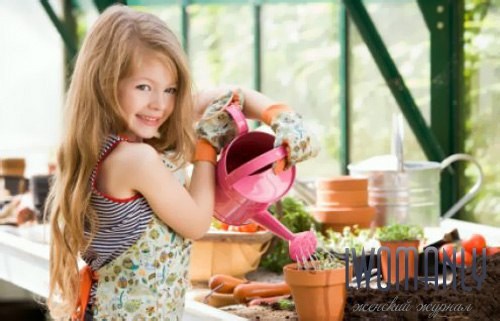
— Plants should be watered only with soft water, as hard water can harm them.
— Water intended for irrigation should be at room temperature.
Fertilizers for indoor flowers
All the nutrients a plant needs for development and growth are obtained from the soil in which it grows. These substances enter through the roots, but plants can also receive some of the nutrients through the leaves, if they are provided with such fertilizing. What substances are considered most important for growth?
Nitrogen
This element is primarily necessary for leaves, as it takes part in the process of oxygen formation. With a lack of nitrogen, the leaves begin to fade and wither. If there is an excess of nitrogen, the leaves become bright green, and the period of development and growth is delayed.
Phosphorus
This element is the main part of the plant's core. If there is insufficient phosphorus, the leaves can become lush green, and sometimes even brown, and the growth process is very slow. Due to excessive amounts of phosphorus, veins become visible on the leaves of the plant (interveinal chlorosis).
Potassium
This element is, first of all, necessary for flowers, otherwise they may not appear at all. If there is insufficient potassium in the plant, ammonia accumulates, causing the leaves to die. With excess potassium, old leaves darken and grown ones become smaller.
Sulfur

If there is a lack of sulfur, growth slows down or stops, and if there is too much of it, the leaves will turn yellow and die.
Calcium
Due to a lack of calcium, plant growth slows down and leaves fall off, and due to its excess, the absorption of nitrogen, iron and potassium is impaired.
The plant needs to be watered at least occasionally mineral water, since it contains carbon dioxide, which, when dissolved, prevents the appearance of limescale on the pot.
Some plants cannot tolerate the smell of cigarette smoke and die in a room where there is frequent and heavy smoking.
When the plant is dormant
Dormancy is a slowdown in the development and growth of a plant. During this period, many processes slow down, and some even stop. The duration of dormancy is influenced by many factors: soil moisture, temperature, amount of light received.
Too low a temperature prolongs the resting time, while a high temperature shortens it. Rest time also reduces a large number. A lot of incoming light also reduces resting time.
In winter, when the length of the day decreases significantly, many plants slow down their growth, and this state lasts until spring. During this period, it is necessary to reduce the amount and frequency of watering.
There is also no need to feed the plant, as this can cause growth arrest and even death.
Some plants require rest because physical features, which is why they must be taken to the bathroom or basement during this period.
At the end of the dormant period, the plant enters the active growth phase. If young new shoots appear, the flower needs to be returned to the room and started to be watered and fed.
At the same time, it is necessary to inspect and replant the plant, as well as remove all dead and infected parts.
Plants that do not require rest in winter simply need to be watered less, but fed regularly.
In winter, a large number of plants often die. This happens due to non-compliance with the conditions for caring for them. In a room, for example, there may be dry air or high humidity, in which, unfortunately, the plant is susceptible to infection by all kinds of viruses and bacteria. That is why it is better to let the plants rest and hide them away from too much high temperatures and bright light.
Fresh air

Plants need fresh air to support their respiration processes. The air we breathe and which surrounds us everywhere contains oxygen and ozone, which are very useful for plant growth. In addition to these gases, it also contains dust and various vapors, the influence of which negatively affects the development and growth of flowers.
Plants are almost half composed of carbon, and carbon dioxide contained in the air is necessary for its entry into tissues. It is absorbed during the formation of air. This process takes place only during the daytime when there is sunlight.
The process of plant respiration occurs continuously. At the same time, they release water and carbon dioxide. All parts of plants breathe, but everyone does it differently. To provide air access for plants in the room, you simply need to open the door or window.
The process of oxygen formation also depends on the brightness of the lighting. At large quantities When light is released, more oxygen is released, and the respiration process slows down, and when there is not enough light, the plant breathes more and produces less oxygen. This happens in winter, when it is recommended to place the plant closer to the light source. For example, it can be placed under a lamp.
All plants tolerate the intake well fresh air. In summer, the room must be regularly ventilated, but you should beware of strong changes in the supply of fresh air, or drafts that can destroy the plant.
If conditions permit, in summer it is better to take the flowers out onto the balcony or plant them in open ground outside so that the flowers receive light and nutrients in large quantities. But in the fall the plants will need to be returned to their original place.
Replanting indoor flowers
If the plant is planted in open ground, its roots take up a lot of space, but if the roots are limited by the walls of the pot, the plant needs to get used to receiving all the substances necessary for development and growth in a small space. To do this, you need to know how to prepare the land.
Different plants like different soil. Some people like slightly acidic ones, while others grow on sour ones. But most plants prefer alkaline soil, and some prefer soil that is rich in lime.
Ready-made earthen mixtures can be purchased at a special store, or you can also make them yourself.
When purchasing a ready-made mixture, you need to carefully study its composition and know which plants it is intended for. If the purchased earthen mixture shrinks into one lump when moistened, it should not be used. The heavy earth mixture clumps into clumps and requires the addition of sand and other impurities. If the mixture is too light, you need to add soil from your garden to its composition.

To properly prepare an earthen mixture with nutrients, you need to know which vitamins and minerals are needed for a particular flower.
That is why it is necessary to remember several rules for preparing earthen mixtures: it is important that there are as many nutrients as the plant needs, no less and no more, the composition must allow water and air to pass well to the root system, and the earth must be harmless in terms of various viruses and bacteria.
It is also worth studying the reaction of the soil in which you will plant the plant. If an acidic environment is necessary for its life, peat must be added to it in large quantities.
The plant needs to be replanted for several reasons:
- if the root system rots;
- if the soil in the pot is completely entwined with roots;
- if the roots have not filled the entire soil, but it is too oxidized;
- if it is noticeable from the appearance of the plant that it lacks nutrients;
- if the root system came out through the holes for draining water.
The transplant must be performed quickly, in otherwise the roots will dry out. Plants cannot be replanted in hot weather.
Ambient humidity

For good plant growth, a certain air humidity is necessary, and if it is low, the plant's leaves fall off and growth stops.
The required humidity can be easily created artificially. Plants should always be sprayed to maintain them water balance and save from dust accumulation. But at the same time you need to be extremely careful with flowers with thick, velvety, large leaves. The fact is that when spraying in the sun, you can burn the leaves.
To increase the amount of moisture in the air, you can place containers of water in the room, place a damp cloth on the radiator and change it periodically to constantly keep it moist. You can also put moss in a pot and water it constantly. But the moss will need to be changed frequently so that bacteria do not infest it.
Spraying should be carried out only with warm water, since cold water can harm the plants (brown spots may even appear on them). Hard water can also be harmful, as it can leave cloudy spots on the leaves.
Many plants are sprayed, as a rule, often: in the mornings and evenings, and some only once a day. It is important to ensure that dust does not accumulate on the leaves, otherwise the plant will have difficulty breathing.
Some plants should not be sprayed at all, as they do not tolerate moisture. Therefore, it is recommended to place them separately from other sprayed plants so that water does not fall on them.
Plant pruning

Not all indoor plants need pruning. Usually, unnecessary shoots and wilted flowers are removed from the plant. In this case, only bushy flowers should be trimmed.
Pruning is the removal of unnecessary parts of a plant to facilitate growth and development, as well as to give the plant an aesthetic appearance. First you need to remove damaged parts (rotten, withered), reduce the length of branches that have grown disproportionately. It is worth pruning both healthy plants and stunted ones (to stimulate their growth).
The more parts of the plant you remove, the faster it will begin to grow back. Pruning should be accompanied by good watering, as well as fertilizing and establishing favorable humidity and air temperature.
The most suitable time for complete pruning is the dormant state in which the plant is located. Then it will be much easier for him to develop. And for the growth period, you can use light pruning, in which only new tender shoots are removed.
Pruning is done with a sharp razor, pruning shears or knife. When pruning, you must be extremely careful so as not to damage the remaining shoots in any way, and after pruning you need to sprinkle the cuts with charcoal.
Types of pruning
1. Pruning to improve sanitation. In this case, all diseased parts of the plant are removed: wilted shoots, yellowed leaves, as well as parts of the plant damaged by insects.
2. Pruning leading to rejuvenation. In this case, all old shoots are removed, or the plant is completely cut off.
3. Trimming to give a certain shape. In this case, the main task of pruning is to give the desired shape plant. This is done to improve its appearance.
When replanting plants, the roots are pruned, but this must be done extremely carefully and to a short length.










